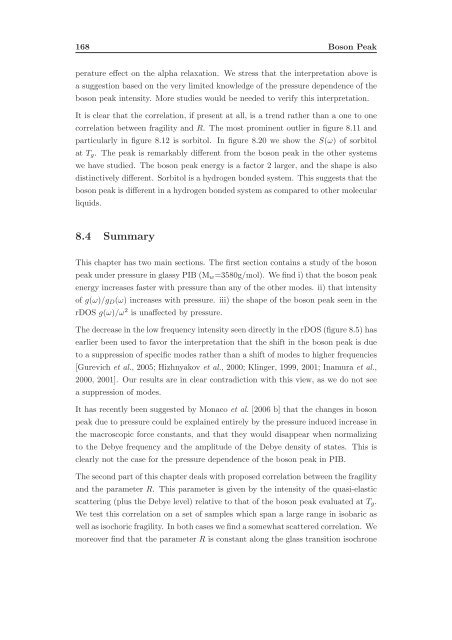Ph.D. thesis (pdf) - dirac
Ph.D. thesis (pdf) - dirac
Ph.D. thesis (pdf) - dirac
You also want an ePaper? Increase the reach of your titles
YUMPU automatically turns print PDFs into web optimized ePapers that Google loves.
168 Boson Peak<br />
perature effect on the alpha relaxation. We stress that the interpretation above is<br />
a suggestion based on the very limited knowledge of the pressure dependence of the<br />
boson peak intensity. More studies would be needed to verify this interpretation.<br />
It is clear that the correlation, if present at all, is a trend rather than a one to one<br />
correlation between fragility and R. The most prominent outlier in figure 8.11 and<br />
particularly in figure 8.12 is sorbitol. In figure 8.20 we show the S(ω) of sorbitol<br />
at T g . The peak is remarkably different from the boson peak in the other systems<br />
we have studied. The boson peak energy is a factor 2 larger, and the shape is also<br />
distinctively different. Sorbitol is a hydrogen bonded system. This suggests that the<br />
boson peak is different in a hydrogen bonded system as compared to other molecular<br />
liquids.<br />
8.4 Summary<br />
This chapter has two main sections. The first section contains a study of the boson<br />
peak under pressure in glassy PIB (M w =3580g/mol). We find i) that the boson peak<br />
energy increases faster with pressure than any of the other modes. ii) that intensity<br />
of g(ω)/g D (ω) increases with pressure. iii) the shape of the boson peak seen in the<br />
rDOS g(ω)/ω 2 is unaffected by pressure.<br />
The decrease in the low frequency intensity seen directly in the rDOS (figure 8.5) has<br />
earlier been used to favor the interpretation that the shift in the boson peak is due<br />
to a suppression of specific modes rather than a shift of modes to higher frequencies<br />
[Gurevich et al., 2005; Hizhnyakov et al., 2000; Klinger, 1999, 2001; Inamura et al.,<br />
2000, 2001]. Our results are in clear contradiction with this view, as we do not see<br />
a suppression of modes.<br />
It has recently been suggested by Monaco et al. [2006 b] that the changes in boson<br />
peak due to pressure could be explained entirely by the pressure induced increase in<br />
the macroscopic force constants, and that they would disappear when normalizing<br />
to the Debye frequency and the amplitude of the Debye density of states. This is<br />
clearly not the case for the pressure dependence of the boson peak in PIB.<br />
The second part of this chapter deals with proposed correlation between the fragility<br />
and the parameter R. This parameter is given by the intensity of the quasi-elastic<br />
scattering (plus the Debye level) relative to that of the boson peak evaluated at T g .<br />
We test this correlation on a set of samples which span a large range in isobaric as<br />
well as isochoric fragility. In both cases we find a somewhat scattered correlation. We<br />
moreover find that the parameter R is constant along the glass transition isochrone

















